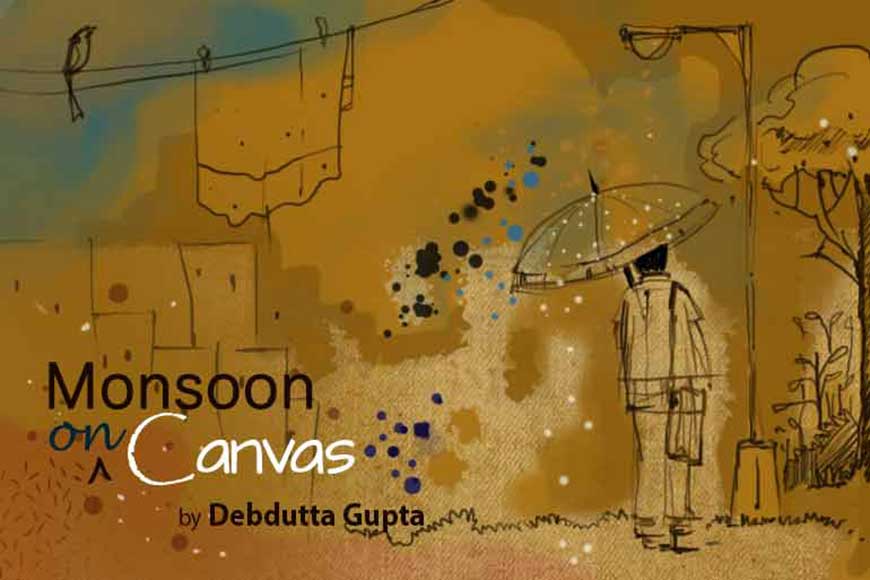Monsoon on Canvas


The rainy season has made a late but grand entrance into Bengal this year. Kolkata has finally drenched her wings. And the time has come to sing to your girlfriend silly band songs like, “Tumi brishti bhijona thanda lege jabe...” (Don’t go out in the rain or you’ll catch a cold) or recite under your breath Joy Goswami’s Jara Brishtite Bhijechhilo (Those Who Had Drenched Themselves in the Rain). It is indeed a fact that during the monsoon season, creative minds all over submerge themselves in original compositions in-between the enticing parallel of khichdi and ilish. Especially it is the artists whose emotions spill across their canvases with the endless currents of rain. As we drench in the pleasant drizzle, let’s take a look at a miniature record of such behaviour. And as for a suitable soundtrack, let’s keep Rabindranath Tagore’s “Gogone goroje megh ghono borosha...” (A cloud-heavy monsoon rumbles in the sky...) on hand. What I’m trying to say here is that artists become unusually prolific when it comes to the monsoon season and as a result, their eccentric creations swing from extreme seriousness to wild nostalgia. In other words, ever since the Mughal era artists have answered to the sensual call of the season by rendering its romance on a blank page. In fact, countless paintings were commissioned by the royal authorities with various compositions on the theme of the season including storm, cloud, rain, thunder, and the eternal love saga of Radha and Krishna. These artists, however, all drew by the book obeying scriptural norms regarding signs, symbols and semiotics.

But the products of Bengal had a slightly different mood with regard to the season. Waterlogged fields, pedestrians with umbrellas, or an entire city flooded with torrential rain can be considered to be some of their persistent themes. Once, Abanindranath Tagore went to Shahzadpur to take care of their family business. Shahzadpur was then submerged in rain. The villages, the local government office, the rail station had all become flooded. And true to his predilections as an artist, Abanindranath abandoned all matters of the zamindari in favour of taking his family boat and his supplies to capture Bengal under the spell of the rainy season.

Like Abanindranath his elder brother Gaganendranath too had drawn snapshots of rural Bengal in the midst of the rains. But what he did in association with his uncle Rabindranath simply has to be mentioned here in length. It was the year 1319 on the Bengali calendar and Shilaidaha’s Nagendranath Gangopadhyay had just published Rabindranath’s Jibonsmriti (Memories of Life) from the Adi Brahmo Samaj press. And in that book, Gaganendranath’s loving illustrations on each page had imparted a vibrantly nostalgic dimension to the words of Rabindranath. In Jibonsmriti, Rabindranath has described the Joransanko Thakurbari as being swept under in rain and has lamented about how his tutor Aghor Babu would brave the storm under a giant umbrella to report for duty. Gaganendranath has tenderly immortalised that moment in soft wash in his own charismatic manner.
On the other hand, artist Ram Gopal Bijoy Borgiyo has profoundly enlivened Kalidasa’s Meghaduta (The Cloud-Messenger) with his illustrations. He has borrowed the way in which storm clouds travelled the sky to depict the story with his own mesmerising lines. Again, Ramkinkar Baij had once sketched rain beating down on a bridge over a canal in Shantiniketan in linocut. The tiny man with an umbrella getting almost swept off his feet in the ongoing storm succinctly expresses the intensity of the downpour. In present times Bikash Bhattacharya and others have also included themes of the rainy season in their landscapes and compositions. In a way, therefore, it is undeniable how the appeal of the season repeatedly makes a poet out of true artists with its own characteristic magnetism.
Translated by Mayurakshi Sen










